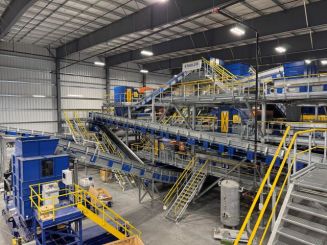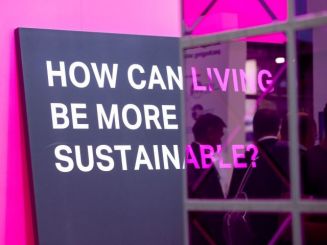
Efficient waste collection and valuable at Ifat
Innovations in every aspect of waste management will be presented at the environmental technology show IFAT between May 5 and 9, 2014, at the exhibition center in Munich.
Set out below are just some examples of this, as announced by IFAT exhibitors at the first IFAT Media Dialog.
At the start of many processes to recover secondary raw materials is the job of collecting the input material. And even in a seemingly simple and well established product such as a waste container there is still further potential for optimization. This was demonstrated clearly in the new refuse and recycling container from SSI Schäfer soon to be presented to the trade audience for the first time at IFAT 2014. Manufactured with new tool and production technology, this container has thinner walls but greater stability and a longer service life, says the company. Using less plastic to make these containers saves resources, of course, but the lightweight design means they are also easier for the waste disposal operatives to handle, and less energy is consumed by the lifting devices on the collection vehicles.
For waste collection vehicles and other municipal vehicles one highly topical subject is the emissions norm Euro VI which has been in force since the end of 2013, beginning of 2014. Many companies have had to find solutions to the higher space requirements of the larger components in the exhaust system as compared to Euro V. Commercial vehicle manufacturers like MAN or Daimler have mastered this challenge in close cooperation with the body builders. And Scania has announced that at the upcoming IFAT it will be presenting the most comprehensive engines program in its history – including biodiesel and gas engines.
Body builder Faun will be showing two new options that can be used by waste-disposal companies to reduce fuel consumption, carbon emissions and noise in their waste-collection vehicles. In the Hydropower system, developed by the Faun Group itself, braking energy is recovered, stored in a hydro storage unit and used to operate the tipping process during the collection tour, without the need to increase the engine revs. The second environmentally friendly innovation from this company is the E-Power auxiliary drive. Here a battery pack that can be charged overnight delivers the energy for the electrical drive of the body and the tipping operation.
On time for IFAT 2014 comes the roll-out of the new generation of skip handlers from the manufacturer F.X. Meiller. Amongst other features their AK 12 product series now has a further enhanced load securing system. The container is secured both in the direction of travel and opposite to the direction of travel by the proven hydraulic container lock. In addition, with this new development, two hydraulically operated lateral clamps grab onto the container – gone are the days of unwieldy operator maneuvering, says the manufacturer. Now it’s all secured by the touch of the button.
In the view of Schmidt Kommunalfahrzeuge local authorities don’t necessarily have to own their waste-collection vehicles. At IFAT this long-standing company will be presenting not only a new small refuse-collection vehicle with a payload of around 5.5 tons but also its rental range of commercial vehicles. According to Schmidt Kommunalfahrzeuge the leasing option means customers get to use the latest technology, have no workshop worries during the rental period and once the contract is ended, they don’t have to go to the bother of selling the vehicle – they simply hand it back.
After collection and transport, many waste and recovered materials then go through an intensive processing phase. The recycling specialist BHS-Sonthofen has so far been known as a supplier of crushing machinery employing impact and shearing forces. Since acquiring the technology from the insolvent AMNI Maschinenbau GmbH in December last year, the company now has products in its portfolio that can be used for recycling elastic materials such as tires or cables. At IFAT 2014 BHS will be presenting for the first time the rotor shears and granulators it acquired.
In many waste-treatment and recycling plants, large quantities of combustible materials are stored and processed. Preventive fire protection is required here. Orglmeister offers its Pyrosmart system for properly and safely monitoring large sites in particular. This consists of an infrared thermal imaging camera and a daylight camera which can scan large areas by means of a mechanical pan/tilt drive. The highly sensitive thermal imaging camera recognizes temperature anomalies in real time. Patented software turns the thermal images into an accurate infrared panorama picture. The user can determine the temperature thresholds as he wishes. When these values are exceeded an alarm is automatically activated. At IFAT Orglmeister will present an equipment combination that links up the Pyrosmart directly to a fire extinguisher from the manufacturer Rosenbauer. This system enables fully automatic detection and extinguishing of fires.
In waste management fire and heat are not only destructive forces, in many applications they can also be very helpful, as exemplified by the pyrolization process to be presented by Pyreg GmbH in May in Munich. During this process moist organic material, for example sewage sludge, is turned into a fertilizer high in phosphorus. But instead of being burned the waste material is pyrolized in a reactor at up to 800°C. Almost all the harmful substances are extracted and destroyed. What remains is a substrate that farmers can simply spread on their land without any further processing. Recovering the natural – and limited – resource of phosphorus is one of the biggest challenges in securing worldwide food production in the future.












